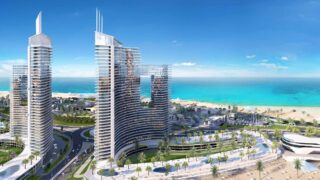This publication file is in the framework of the activities of the network of independant media on the Arab world. The regional cooperation is made by Al-Jumhuriya, Assafir Al Arabi, Mada Masr, Maghreb Emergent, Mashallah News, Nawaat, 7iber and Orient XXI.
In Upper Egypt, where people face the scorching sun, coupled with harsh poverty, and among fields covered in green and others left fallow, there lives Mohamed Khairy in a poor house in an Upper-Egyptian village of Al-Qarah, or as called by villagers “Al-Garah”, which is traced back to Pharaons era. It is located in the Abu Tesht District, northern Governorate of Qena, to the west of River Nile. Khairy, 29 years old, who holds an Industrial Technical Diploma, has been working in agriculture from his early childhood. However, he cannot do it any more, so he earns his and his family’s living as a driver. Khairy moved from agriculture to driving after being unable to cultivate the seven acres he owns to the west of village due to shortage of water.
Khairy and his village are a model for many villages in Upper Egypt, known as “Mountain Line” villages by the villagers, which suffer from water poverty in the accurate meaning of word - “Inaccessibility to Water”.
Due to greater distance from the Nile and being situated on a high area, these villages relied, for many years in agriculture, on extracting water from wells using diesel-powered machines. Later, the Egyptian Government decided to lift energy subsidies gradually within the framework of the “Economic Reform” scheme, whereby Egypt was granted a loan of USD 12 billion by the International Monetary Fund (IMF) in 2016. Inaccessibility to diesel contributed to the abandonment of agricultural activity by some people, while others attempted to find alternatives as the concerned authorities neglected the crisis.
**
“Al-Garah”, a mainly agricultural village, is inhabited by approximately 15 thousand people. Its agricultural lands are divided into two parts: The Eastern part, which covers the old land adjacent to River Nile, extending to 700 acres and is irrigated by Nile channels ; while the western part is far from the Nile and depends on wells for irrigation. It covers approximately 2000 desert-mountainous acres reclaimed by villagers thirty years ago after the village narrowed due to overpopulation.
Khairy's father was one of the desert seekers. He managed to reclaim the 7 acres, which were passed to his son. Khairy and his family earned their living from cultivation, which was later suspended amidst the ramifications of the decisions to lift energy subsidies and liberalize the exchange rate.
Khairy continued to cultivate the land for three years until 2018, but could not afford the cost of water extraction. He tells Mada Masr: “After the increase of the price of diesel, the land is no longer profitable. For many seasons, I lost money and became indebted, so I decided to abandon it barren.”
The decrease of energy subsidies resulted in an increasing cost of water extraction, given that the irrigation cost was doubled. One litre of diesel, over the past years, rose from EGP 1.6 to more than EGP 7.
As reported by Khairy, one acre needs water three times per month. One acre consumes two 40-liter gallons of diesel each time. Before the governmental actions, the cost of irrigating one acre was nearly EGP 128. Following such actions, the cost of irrigating one acre hiked to EGP 270 during the past few years.
As reported by Khairy and other farmers to “Mada Masr”, the daily ratios of irrigation for summer crops, such as cantaloupe, tomatoes, clover and maize have increase due to the high temperature, resulting in an increase of water accessibility costs during the summer. Therefore, continuing cultivation during the summer is almost impossible for “Mountain Line” villages, according to Khairy.
As a result, according to an agricultural engineer from the village, who refused to disclose his name to “Mada Masr”, those who were better off cultivated a portion of land, while others prefer to only cultivate during winter.
“Khairy” had no other option but to look for another source of income. He had the opportunity to go abroad, as he travelled with his brother to KSA, leaving behind his father’s land uncultivated. Khairy says, “The poverty witnessed in Al-Garah left no choice. I have a house and child to support and I have a land that I can’t cultivate”.
Khairy's experience was not the only one in Al-Garah. His story resembled many other stories of landowners in the village who talked to Mada Masr. Ashraf Atef, 34 years old, is working as a housekeeper in a hotel in the Red Sea city of Marsa Alam, after failing to cultivate his land. Atef worked for many years after finishing his studies in Cairo and hardly managed to provide the costs of cultivating 5 acres westward of the village, which he inherited from his father, to be cultivated by his uncle on his and his brothers’ behalf. This cash flow stopped following the governmental decisions about six years ago and until today.
When “Khairy”, as well as “Atef”, returned to “Al-Garah” in pursuit of a livelihood, having lost their jobs abroad and onshore amidst COVID-19, they found that their neighbours managed to cultivate their lands once again using solar power.
The “Al-Samman” family, which owned 20 acres of land, was one of them. Early this year, the family, managed to cultivate its land completely after they had stopped cultivating more than 85% of the total area for many years.
“For three years, we grew our food and our livestock feeding, using only 3 acres, while the remaining left uncultivated”, reported by Omar Al-Samman, a student at Islamic Studies College, to Mada Masr. He added that cultivation of family land was costing EGP 3 thousand per week.
The Al-Samman family were enthusiastic about solar power as one of the district’s agricultural engineers offered the service in instalments last year. The family was not hesitant, especially after witnessing the result of the amazing experiment on their neighbours’ land after using solar power. Such technology saved them a lot of money and endless problems due to failures of traditional irrigation pumps.
Despite the high costs of installing solar panels, costing EGP 325 thousand for “Al-Samman” land, such cost is temporary and ends upon payment or completion of the instalments, according to “Al-Samman”.
As reported by Eng. Al-Shazly Yasin, owner of one of the solar energy companies that provides services to villagers and some southern governorates, the demand for solar panels for agriculture purposes has increased during the past five years following the increase of diesel and electricity prices. Most similar companies are offering various instalment schemes to encourage demand for green energy, according to Yasin.
The costs of installing solar panels to extract water from wells for irrigation of crops vary according to land area and water depth.
This option was not available to all farmers, including Atef and Khairy, according to the agricultural engineer, who stated that 20% of “Mountain Line” farmers could replace diesel with solar power for agriculture. Meanwhile, small farmers with limited areas of land and poor financial conditions, have resorted to cooperating with their neighbours to take part in instalments for solar power technology to irrigate their lands. They shared irrigation timings equally.
“Mountain Line” villages on the western side of the Nile, including Al-Garah and other Upper-Egyptian villages, are listed for years on the poverty plan issued by the Central Agency for Public Mobilization and Statistics, which describes in detail the spatial distribution of poverty biannually.
The Central Agency for Public Mobilization and Statistics set the poverty line, in recent data of income and expenditure, at EGP 857 monthly or EGP 10.283 per annum, equal to USD 1.79 on a daily basis, while the World Bank adopts USD 1.90 per day.
The Government seemingly attempts to address the ramifications of poverty resulting from the decline in employment rates restricted to the agricultural sector. Therefore, it enlisted many villages of “Mountain Line” in the Decent Life Scheme, early this year. This Scheme was launched by the Government of Egypt in 2019 to provide support to the most vulnerable groups in all aspects of the service, such as health, education and housing. It was considered by the Local District employee as a treatment for poverty, while the main reason, which is water poverty, is overlooked.
As per the United Nations' International Covenant on Economic, Social and Cultural Rights, access to water for agricultural purposes, particularly for small farmers, is covered by the right to sufficient food. The UN ICESC states that water resources are necessary to avoid famine and diseases and should be prioritized.
“Al-Garah’s” economic scene, which is restricted to agriculture alone, uncovers the present and former government's marginalization of Upper-Egyptian villages with regards to the issue of water. The villagers depended on themselves to create the agricultural extension of the village through the desert-mountainous hinterland, in the absence of any governmental initiatives to support the impoverished farmers in replacing the traditional water pumps. As reported by Mahmoud Al-Samman, Head of Organization and Properties, Village's Local District, such initiatives require a large-scale investment project, which is still awaited for.
Amro Adly, Professor of Political Economy, AUC, states, “Al-Garah is a model for absence of coordination between local development initiatives and social capital on the one hand, and governmental intervention in general investment on the other hand. It is attributed, according to Adly, to the absence of local districts resulting from centralization, which is an inherited legacy.
Adly attributes the absence of governmental efforts in Upper Egypt to political dimensions, as the Upper-Egyptians are not deemed as a source of popular movement from a governmental viewpoint. “They are marginalized because they are not only poor, but also far from administration and control centres, so they are not feared from the popular side”, Adly adds.
As reported by Eng. Al-Shazly Yasin, owner of one of the solar energy companies that provides services to villagers and some southern governorates, the demand for solar panels for agriculture purposes has increased during the past five years following the increase of diesel and electricity prices. Most similar companies are offering various instalment schemes to encourage demand for green energy, according to Yasin.
The Government, on its part, did not react to the villagers’ initiatives to use solar power in irrigation, according to sources in the Agricultural Society and Local District which Mada Masr spoke to. Mahmoud Al-Samman, Head of the Organization and Properties department in Al-Garah’s Local District, reitirates.
“Currently, there is no official intention to undertake initiatives to install solar power for agricultural lands instead of diesel”. “Each farmer can install it at their own expense and choose the payment method they prefer, given that the agricultural water needs require a large investment project”.
Published in Mada Masr on 07/07/2021
_____________________________________
-Nada Arafat, freelance journalist rewarded for her work, she writes mostly for Mada Masr.
-Omaima Ismail, journalist at Mada Masr





